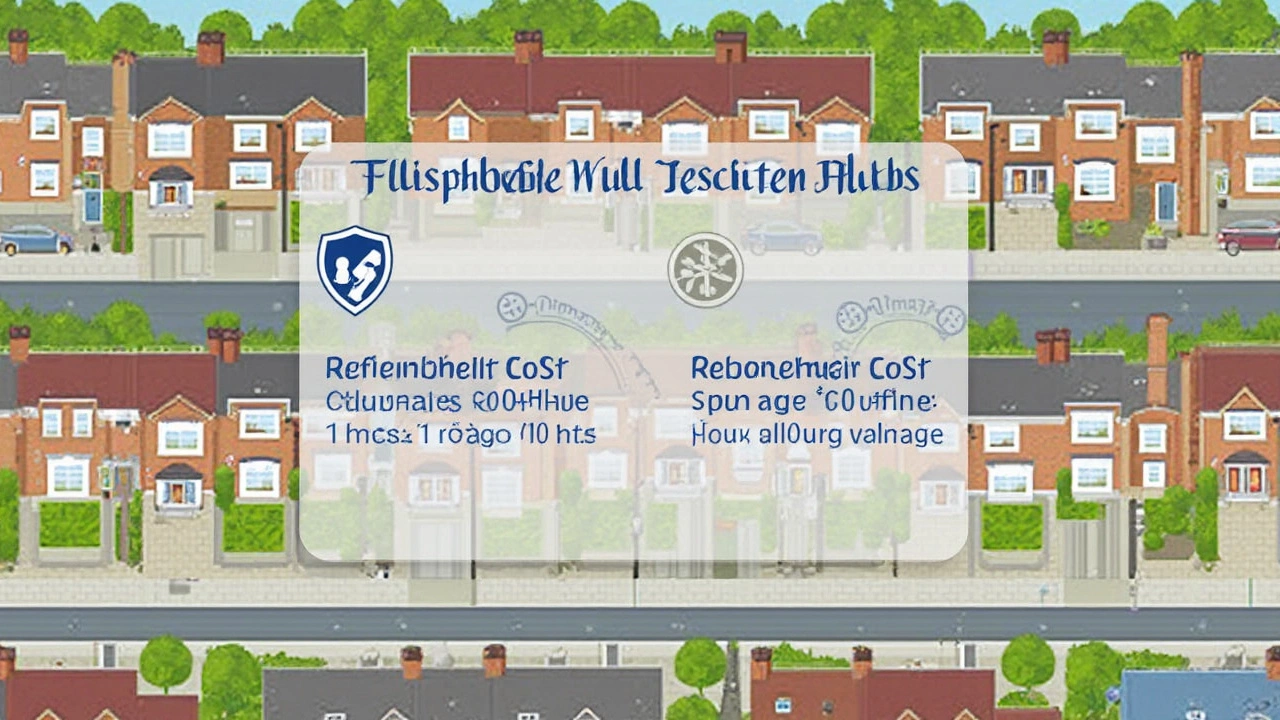If your homeowners insurance talks about the '80% rule' and you just nod along—you're not alone. This rule isn’t just some boring clause in the paperwork; it can actually decide how much money you get when disaster strikes your home.
Here’s the gist: Insurers expect you to carry at least 80% of your home’s replacement cost on your policy—not the market value, but what it’d take to rebuild from scratch with today’s materials and labor. Miss that mark, and your payout could get sliced, even if your claim is small.
Think of it like this: If rebuilding your place costs $400,000, the 80% rule says you should insure it for at least $320,000. Go lower and the insurance company will either pay only a fraction for repairs or possibly leave you footing a big chunk of the bill.
- What Is the 80% Rule?
- How the Rule Impacts Claims
- Calculating the Right Coverage
- Common Missteps and Real-World Scenarios
- Tips to Avoid Surprises
What Is the 80% Rule?
The 80% rule is a common standard in homeowners insurance. It means that to get full coverage on a claim, you must insure your home for at least 80% of its replacement cost. This isn't about what you could sell your house for—it's about how much it would cost to rebuild the whole thing, top to bottom, using current prices for labor and materials. So if disaster hits, your insurance only pays out the full amount if you have coverage that meets or beats this number.
This rule comes from insurance companies wanting policyholders to buy enough insurance so everyone chips in fairly for the pool of money used to pay claims. It also stops folks from buying super-low coverage and still expecting big payouts after a loss. That’s why the 80% rule shows up pretty much everywhere in home policies.
Here's how it looks in practice: say your home's replacement cost is $500,000. To meet the rule, you'd need at least $400,000 worth of coverage. If you go lower, like $300,000, your insurer will likely reduce their payout on your claim, even for minor repairs—not just total losses.
| Replacement Cost | Required Coverage (80%) |
|---|---|
| $300,000 | $240,000 |
| $400,000 | $320,000 |
| $500,000 | $400,000 |
So, the simplest way to think about the 80% rule is this: If your coverage amount is less than 80% of your home’s replacement cost, you could be on the hook for part of the repair bill—even if there isn’t a total loss.
Replacement cost can change over time with inflation, building codes, and local labor costs. It's smart to check your policy every year to make sure you’re still above that 80% threshold.
How the Rule Impacts Claims
This is where the 80% rule can hit the hardest. When you file a claim, the insurance company checks your coverage amount against your home's actual replacement cost. If you've got at least 80% of the replacement cost covered, you're in the clear—they pay out the full replacement cost (minus your deductible, of course). If you're below that 80% threshold, things get tricky.
Here's what actually happens: the insurer uses a formula to figure out how much they'll pay. They divide the amount of insurance you carried by 80% of your home's replacement cost, then multiply that by the amount of your loss. You end up footing more of the bill, even if your claim is for something small, like a kitchen fire.
For example, say your place costs $400,000 to rebuild, but your policy only covers $250,000. Here's how a $50,000 damage claim shakes out:
| Replacement Cost | 80% Required | Coverage You Have | Claim Amount | Payout (before deductible) |
|---|---|---|---|---|
| $400,000 | $320,000 | $250,000 | $50,000 | $39,062.50 |
You'd get just under $40,000—even though the claim was for $50,000. The other $10,000 comes out of your pocket. This is called a 'coinsurance penalty.' It applies whether your insurance claims are big or small, and it's triggered each time you don't meet the 80% rule. No exceptions.
- If your coverage meets or beats the 80% line, you're paid fully for covered losses, minus your deductible.
- If you fall short, you'll get only part of your claim covered.
- Even minor lapses in coverage can mean thousands of dollars less in a payout.
Most people miss this because they're looking at their mortgage balance or the market value of their house—not what it would actually cost to rebuild. And those numbers can be wildly different, especially after building materials or labor costs shoot up (think inflation or supply shortages).

Calculating the Right Coverage
Getting your homeowners insurance coverage right is more math than magic. The golden rule: you need at least 80% of your home’s replacement cost insured, not its current market value. Replacement cost is what it truly takes to rebuild your house from the ground up with the same materials—think lumber, roofing, windows, labor, and even little details like kitchen tile or trims. People sometimes get this confused with how much they could sell their house for, but that number can throw your insurance way off.
First, you’ll need to figure out your home’s replacement cost. Most insurance companies offer a cost estimator, but you can double check by talking to a local contractor or using reputable online calculators. Prices for labor and materials go up fast—lumber alone doubled in 2021! So don’t just use last year’s numbers. A survey from the Insurance Information Institute found that 60% of homes in the USA are underinsured mostly because of outdated replacement cost estimates.
Some must-dos to nail the right coverage:
- Contact your insurer and confirm how they calculate replacement costs in your area.
- Ask for a replacement cost estimator or hire a pro to get a real number.
- Don’t include land value—just focus on the house itself.
- Update your estimate after any renovation, like finishing a basement or adding a deck.
- Check for special features (custom cabinets, built-ins, solar panels) that might push up your replacement cost.
To make life easier, here’s a quick example. Say your home’s replacement cost is $350,000. The 80% rule says your policy needs to cover at least $280,000. Drop below that, and your claim payment might shrink fast. Here’s a simple reference table:
| Replacement Cost | 80% Minimum Coverage | Insured For | Result |
|---|---|---|---|
| $350,000 | $280,000 | $290,000 | Full claim payout |
| $350,000 | $280,000 | $200,000 | Partial claim payout (80% rule not met) |
“If you haven’t checked your home’s replacement cost in the last year, you probably need more coverage than you think,” says Loretta Worters, spokesperson for the Insurance Information Institute.
It’s not complicated, but missing the right number could smack you with a bigger bill than you ever expected if disaster strikes. Grab a calculator or call your agent—it’s worth it.
Common Missteps and Real-World Scenarios
Here’s where a lot of people run into trouble with the 80% rule in homeowners insurance—often without realizing it until something goes wrong. The most common mistake? Insuring the house based on what you paid for it or its current market value instead of the real replacement cost. The cost to rebuild can skyrocket with inflation, material shortages, or even stricter local building codes.
One example: Jen thought her $250,000 in coverage was plenty since her home’s market value was $240,000. After a kitchen fire, it turned out that rebuilding today would run $320,000. Her claim was reduced because her policy didn’t hit that crucial 80% of replacement cost. She got less than she expected and had to dip into personal savings for repairs.
Another common misstep is forgetting to adjust coverage after renovations. Let’s say you add a finished basement or a new sunroom. These upgrades boost the replacement cost but, if you don’t bump up your insurance limit, you could find yourself underinsured.
Want some proof of how often this happens? Check this out:
| Scenario | Percentage of Homeowners Affected |
|---|---|
| Underinsuring homes below 80% | About 60% |
| Not updating coverage after renovations | Nearly 45% |
| Confusing market value and replacement cost | Over 50% |
Even seasoned homeowners get tripped up. Maybe you remodel, prices climb, or you just let those annual policy review emails slip by. Suddenly, you’re not meeting the 80% rule and face out-of-pocket costs when you file an insurance claim.
This is why staying on top of your coverage really matters. Home insurance isn’t set-it-and-forget-it. Take a fresh look at your policy after any major home change or once a year, so you don’t get blindsided if a claim ever comes up.

Tips to Avoid Surprises
No one wants to find out their homeowners insurance policy isn’t enough after something goes wrong. There are a few steps you can take right now to stay on the safe side of the 80% rule.
- Recalculate every year: Building costs change, and so should your coverage. Most insurance companies recommend reviewing your policy annually. A 2024 report from the National Association of Home Builders said rebuilding costs jumped by nearly 15% in some regions the previous year, so yesterday’s number probably won't cut it.
- Don’t use your home’s market value: The price you paid for your house isn’t what matters for insurance. Replacement cost is all about what it would take to rebuild from scratch—think contractor fees, lumber, roofing, and even labor shortages.
- Ask for a professional estimate: Many insurance companies offer free or low-cost replacement cost assessments. Get a pro to walk through your place and give you a realistic figure so you’re not lowballing yourself.
- Update after renovations: Add a new kitchen or bathroom? Your home’s replacement cost may have jumped. Let your insurance company know, or you might fall below that magic 80% number without realizing it.
- Double-check add-ons: Major upgrades like finished basements, decks, or solar panels can bump up rebuilding costs. Be sure they're included in your coverage estimates.
Here’s how forgetting about the 80% rule has cost people money, based on real claims data:
| Situation | Replacement Cost Needed | Policy Coverage | Payout After Claim |
|---|---|---|---|
| Fire damage | $300,000 | $200,000 (below 80%) | Only $133,333 paid |
| Storm damage | $350,000 | $280,000 (barely above 80%) | Full claim paid |
Little details add up. The key tip: Don’t just trust online tools or guesswork. Checking your replacement cost and coverage limits is the only way to know for sure you’re covered. Being proactive now will save you major headaches—and money—later.
